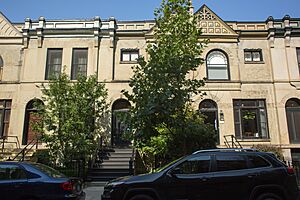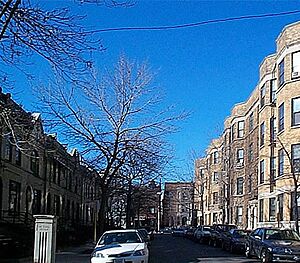Society for Human Rights facts for kids
| Named after | Bund für Menschenrecht |
|---|---|
| Founded | 1924 |
| Founder | Henry Gerber |
| Dissolved | 1925 |
| Type | non-profit organization |
| Location |
The Society for Human Rights was an American group started in Chicago in 1924. It was created to help and support gay people. The founder, Henry Gerber, was inspired by the work of a German doctor named Magnus Hirschfeld. He also learned from a German group called Bund für Menschenrecht, which means "Association for Human Rights."
This Society was the first recognized gay rights organization in the United States. It received official permission from the state of Illinois. The group also created the first American magazine for gay people, called Friendship and Freedom.
However, the Society did not last long. Just a few months after it started, some of its members were arrested. Because of this, the group had to stop its work. Even though it was small and short-lived, the Society for Human Rights is seen as a very important step. It helped start the modern movement for gay rights.
Henry Gerber: A Pioneer for Rights
Henry Gerber moved from Imperial Germany to the United States in 1913. He settled in Chicago with his family. Many German-speaking people lived there. A few years after he arrived, he faced unfair treatment because he was gay. In 1917, he was sent to a hospital for a short time because of this.
When the United States joined World War I, Gerber joined the United States Army. After the war, he worked as a printer in Germany from 1920 to 1923. He was part of the Allied Army of Occupation in a city called Coblenz.
While in Germany, Gerber learned about Magnus Hirschfeld. Dr. Hirschfeld and his Scientific-Humanitarian Committee were working to change unfair German laws against gay people. Gerber visited Berlin many times. Berlin had a lively community for gay people. He also read magazines for gay people. He was very impressed by the group Bund für Menschenrecht, led by Friedrich Radszuweit and Karl Schulz. He learned many ideas from Dr. Hirschfeld. After his time in the army, Gerber returned to the United States. He began working for the post office in Chicago.
Starting the Society for Human Rights
Gerber was inspired by the work in Germany. He decided to start a similar group in the United States. He named his group the Society for Human Rights. This was an English translation of the German group's name. Gerber became the secretary of the new group.
On December 10, 1924, Gerber applied for official permission from the state of Illinois. He wanted the Society to be a non-profit organization. This means it would work for a cause, not for money. The application explained the group's goals. It said they wanted to:
- Help people who were treated unfairly because of who they were.
- Fight against public unfairness by sharing facts with smart adults.
- Follow all laws that protect people's rights.
- Not encourage anything against the law or public good.
An African American religious leader named John T. Graves became the president. Gerber, Graves, and five other people were listed as leaders. The state officially approved the group on December 24, 1924. This made the Society the first known gay organization in the country. The group members were surprised. They had kept their goals general and did not mention homosexuality directly. They thought the state might investigate more before giving approval.
The Society also had a newsletter called Friendship and Freedom. It was the first magazine for gay people in the United States. Gerber wrote and produced both issues himself. Sadly, no copies of the newsletter are known to exist today.
Gerber had a three-part plan to help gay people gain equal rights:
- Give talks to explain how society viewed their behavior.
- Create a publication to keep gay people updated on their efforts.
- Help gay people learn self-control. This would help them gain trust from legal authorities. It would also help lawmakers understand that long prison terms for gay acts were not helpful.
Gerber tried to get more people to join the Society. But he found it hard to get people other than poorer gay individuals to join. He also could not get financial help from wealthier gay people in Chicago. Gerber also tried to get support from doctors. He was frustrated when they would not help. They were worried about what others would think if they helped gay people.
In 1962, Gerber thought back on these difficulties. He said it was hard to find enough members and money. He found that many gay people did not understand themselves. Others were scared. Some were not interested. He wondered how they could achieve anything with such resistance from their own community. Gerber took on all the work and paid for the Society and Friendship and Freedom himself. He was happy to do it, hoping he would be remembered as a great leader for gay rights.
Lasting Impact of the Society
Henry Gerber and the Society for Human Rights connect early gay rights efforts in Germany to the American gay rights movement of the 1950s. In 1929, a young man named Harry Hay lived in Los Angeles. He met a man named Champ Simmons. This man told Hay about the Society's short history. He warned Hay that organizing gay men might be difficult.
Even though Hay later said he didn't know about earlier gay rights work, he was inspired. In 1948, he thought of an idea for a political and social group for gay men. In 1950, Hay's idea became real. He and others started the Mattachine Society. This was the first lasting gay rights organization in the United States.
Henry Gerber was honored after he died. In 1992, he was added to the Chicago Gay and Lesbian Hall of Fame. The Henry Gerber House is at 1710 N. Crilly Court, Chicago. This is the apartment where Gerber lived when he started the Society. It was named a Chicago Landmark on June 1, 2001. In June 2015, it was named a National Historic Landmark.
The Gerber/Hart Library in Chicago is named after Henry Gerber. It is also named after Pearl M. Hart, an early supporter of civil rights.




